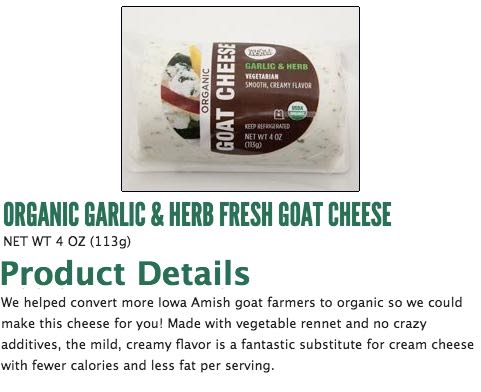You know what brand is. It's the difference between this:

... and this:

Your brand is the public face of your business, encompassing everything your consumers see. Your name, logo, marketing strategy, and product and service design all contribute to your brand.
What Is Brand Voice?
Brand voice is much more specific. It comes from the words you use, the tone of the communications that come from your business. When it comes to digital marketing, your brand voice is determined by the content of your:
- Website
- Digital advertisements
- Email newsletters
- Social media accounts
- Blog posts
Your brand voice is, of course, a critically important part of your marketing strategy. The relationship you have with your customers depends on it, and recognizable companies tend to have strong and clear voices.
Having a distinctive voice is especially important when you're pursing a content marketing strategy, one of the most effective forms of marketing there is.
Match the Brand to the Content
Here's an exercise that will take just a few seconds. Both of these snippets are from the first paragraph of a major tech company's privacy policy. Can you tell which one came from Google, and which one came from IBM?
At [our company] we recognize the importance of protecting your personal information and are committed to processing it responsibly and in compliance with applicable data protection laws in all countries in which [we] operate.
Compare that with:
When you use our services, you’re trusting us with your information. We understand this is a big responsibility and work hard to protect your information and put you in control.
The difference between the two quotes is pretty apparent. Both communicate the same thing, but the first is noticeably more technical and formal. The second quote is casual, even conversational. It's written with much shorter words and sentences. If you guessed that the second quote came from Google, you were correct.
With these quotes, both companies are trying to get the idea across that they're trustworthy. The ways they get that across, and the way they want you, the consumer, to feel, are very different. IBM is saying, "We're competent and no-nonsense. We know what we're doing." Google is telling you, "We're on your side, and we're not going to let you down."
This matches their respective identities. Although they are not direct competitors, both companies have famously different brands (and company cultures): Google's is younger and hipper, friendly yet professional. IBM's identity is serious and businesslike. Neither choice is right or wrong, but they are very different.
Imagine those identities being expressed thousands of times across their websites and every other piece of digital content they produce, and you have a good idea of what brand voice is.
Developing a Brand Voice for your Business
Maybe you already know what voice you want for your business.
But maybe you're not sure. Even though most successful companies' brand voices feel natural, even inevitable, as though there was never a chance of them choosing something different, most of them took a lot of work to arrive at. Google's brand, for instance, was the culmination of decades of reinvention and evolution.
How do you determine what your company's brand voice should be? When you decide, it helps to follow several simple steps.
1. Consider Your Target Audience—And Not Just Their Demographics
If you've read about this anywhere else, you've been told that you need to consider your target audience. That's good advice.
If your audience consists of older professionals, then you should consider a serious brand voice, with a high information-to-persuasion ratio. On the other hand, if they're mostly college students, you might want something casual, maybe something funnier, with a focus on creating friendships with your customers. For every demographic, there's plenty of research out there telling you what they want, and it's well worth checking it out.
However, what many guides fail to mention is that demographics cannot be your only consideration. You also need to think about the mindset that your consumers are going to be in when they view your material.
Match Your Voice to Your Products or Services
If your business deals with sensitive issues—for example, with people's finances, legal issues, or anything pertaining to healthcare—there's a chance that many of your potential customers are going to be in an anxious frame of mind when they go looking for your services. They have a problem, maybe a bad one, that they need solved by someone who they can tell is competent above all.
This means that a lighthearted, comic voice is probably not going to make a great impression on them. When they're viewing your material, they're not in the mood to be entertained. They want to be reassured. They want you to come across as authoritative and reliable. An almost parental voice can be appropriate in these cases.
Exercise-induced #asthma usually happens after #exercise that's vigorous enough to significantly increase your heart rate and #respiration. ➨ https://t.co/RlbEFa6eLe
— UCLA Health (@UCLAHealth) January 26, 2019
That's what this tweet from UCLA Medical Center is doing. It's dispensing medical advice in a serious, to-the-point manner, but without being as remote and technical as, say, IBM's privacy policy. They're careful to put a human face on their advice. The tone they strike is serious but reassuring.
On the other hand, if the services or products you offer have lower stakes, then an informal (even slightly edgy) tone can make a good impression.
Insightful https://t.co/OwgUPQTE3B
— Hot Pockets (@hotpockets) January 14, 2018
When Hot Pockets (owned by Nestlé) engages in banter with their followers on Twitter, which they do frequently, it's funny and it works. Think about whether that would seem appropriate coming from a security consulting firm or healthcare provider.
When you pick your brand voice, consider the impression you want to make on your customers. In the end, it comes down to deciding what qualities are the most important for your business to convey. You can't be all things at once.
Is it more important to demonstrate that your business is composed of likable individuals—that it's not a faceless conglomerate—or that it is a reliable and powerful entity that will be able to quickly solve their problems?
Formal or Casual: The First Choice, But Not the Only Choice
You've probably noticed that a lot of your brand voice comes down to how formal or casual you decide to be. That is the first and biggest decision about it that you need to make, but it's not the only decision. Once you make it, you have to refine it.
If you chose a casual tone, do you want to be funny? If you do, should the humor be light and good-natured, or a little bit snarky, like the Hot Pockets tweet? If you pick a serious tone, should it be warm and comforting, somber, businesslike, or academic?
2. Picture Your Brand as a Person, Then Describe Them
To refine your tone, try imagining a series of people, each one being the kind of customer you're likely to have. (Here's where it helps to do some demographic research.) Imagine them sitting across the table from somebody representing your brand.
What kind of person does each one of your prospective customers want to talk to? How would they be dressed? Would they rather talk to someone in a suit, or a T-shirt? Do they want to be joked with? Imagine somebody who would be able to have a positive conversation with every one of your customers. Picture them in your head, and you've found your brand voice.
Once you have that in your head, don't let it go. Write it down.
To keep it simple, you can jot down as many adjectives describing this person representing your brand voice as you can. Once you have a list, try to narrow it down and mark the most important adjectives. It can also help to write down what it should not be. Try to pare it down to a maximum of five.
When you do this, try not to fall into the trap of picking adjectives that any business would want to apply to them. You might be tempted to write down "trustworthy", but that's not particularly useful. What business wouldn't want to be perceived as trustworthy?
That's why it helps to describe a person that you're visualizing. It keeps your description as concrete and specific as possible. If it helps, feel free to write it in paragraph form—you can always pare it down to a few adjectives later.
3. Make Sure Your Voice is Consistent With the Rest of Your Brand
Your brand voice does not exist in isolation. It exists alongside your brand's visual identity–your logo, the tone of your ads, even the design and layout of your website.
If your business's logo, ads, and website are professional and restrained, then the words on them should not be zany and exuberant. They'll clash, leaving your customers with a confusing mix of signals.
Here's another exercise. Here are two pieces of content from two websites, Mailchimp and SendinBlue. The two companies offer very similar services (both are email marketing platforms), and, once again, the two quotes communicate almost the same thing. Which quote goes with which logo?

And the content:
Build your brand.
Sell more stuff.
Sign Up Free
Marketing Campaigns Made Easy: Leverage email and SMS marketing campaigns to inform, engage and convert.
Sign Up for Free
The first quote goes with Mailchimp's logo. It uses the word "stuff", a word you won't see appearing anywhere on SendinBlue's website. It's Google vs. IBM all over again—casual vs. professional.
Their identities are so clearly defined that it's possible to match copy from their websites to their logos without any other cues. All the aspects of their brand, textual and visual, are consistent with each other.
This brand consistency ensures that their identities feel natural. Everything works together to maintain their chosen tone. This is exactly what you want for your business, so when you invent (or reinvent) one aspect of your brand, make sure you don't forget all the others. And make sure the different wings of your marketing team are communicating with each other.
4. Find Out What Your Competitors Are Doing, Then Do Something Different
Mailchimp and SendinBlue are interesting examples because they both had complete freedom in picking their brand voices.
Some businesses have relatively few choices in this area. A funeral home's brand voice, for example, can be quiet and somber, or warm and comforting, but definitely should not be snarky and irreverent.
On the other hand, for an email marketing service, nothing is going to seem wildly out-of-place. Businesses like this have the freedom to play around, which means that it's worth asking why MailChimp and SendinBlue chose their identities.
It's not too hard to guess why Mailchimp picked theirs. As indicated on their About Us page, they were founded in 2001, and chose their lighthearted brand identity early on—it matched their company culture as a tech startup.
Mailchimp's brand was firmly established when SendinBlue was created in 2012. In the face of such entrenched competition, SendinBlue did not try to copy their brand voice, even though Mailchimp's strategy had obviously been effective.
Why not? Because the two were direct competitors. (SendinBlue even has a page explicitly comparing their services.)
If SendinBlue had sold themselves as another Mailchimp, they would have seemed like a knockoff. Instead, they forged a distinct identity that enabled them to sell themselves as an alternative—which put them in a good position to compare the price and reliability of their services.
Especially if you're a newcomer to your industry, following one of your competitors too closely will usually make you seem inauthentic, making a poor impression on your potential customers.
You don't have to go in the complete opposite direction. For example, as boutique grocery stores, Trader Joe's and Whole Foods have brands that are superficially a lot alike. However, when you look past the surface, they emphasize different things. This is especially evident in their product descriptions, which make a crucial part of a retailer's content marketing strategy.
Compare these two product descriptions, both for higher-end cheeses:

See the language they're using? This cheese is organic, made with no additives, and has fewer calories and less fat per serving. In plain language, they're emphasizing that it's good for you.
Let's look at Trader Joe's.

Six lines in and they haven't mentioned health once. Instead, they want you to know how they went on a valiant quest for this product. Their description is all about adventure, and its language is colorful and exuberant.
Trader Joe's puts the focus on their rare and exotic goods, whereas Whole Foods stresses that their products are organic and healthy. This is enough to differentiate them and protect each from the accusation of being a copycat.
Pay attention to what your competitors are doing. Just remember to put your own spin on things.
You've Picked Your Brand Voice. Now What?
You've followed the steps above, and chosen a brand voice that you're happy with. Good work! Now, how do you implement it, particularly when you're pursuing a content marketing strategy?
The question has two answers. First, you need to provide very clear directions to your writers; second, you need to have the right writers.
Provide Clear Tone Guidelines ...
Whether they work in-house or you're outsourcing, your writers need to understand your expectations.
Remember that list of adjectives you came up with above? Show that to your writers. In fact, while you're at it, show it to your business partners, to your marketing team, to absolutely anybody who might be involved in content creation.
Remember that for your brand voice to be consistent, everybody needs to be on the same page.
... To People Who Know How to Follow Them
It's not enough to give clear instructions to your writers if you're not confident in their ability to implement them. Style and tone can be tricky to master; not every writer is comfortable writing in every voice. That's even true for many highly-skilled writers. Someone who's great at writing BuzzFeed-style listicles might be utterly out of their depth writing an informational post comparing auto insurance services.
And when it comes to following your guidelines, your writers have two jobs. They don't just need to be comfortable writing in your brand voice, they also need to listen to you when you describe what your brand voice is.
Choose a Platform That Meets Your Needs
Sound like a lot to keep track of? It is. Keeping a consistent brand voice can be difficult and stressful. To do it, you need to manage a team of writers and make sure that they get it right every time.
If it all seems like a lot of work, think about letting our team at Compose.ly handle the job for you. Picking the right voice was hard enough. You shouldn't have to worry about maintaining it too.

.svg)
.svg)



